
The Court of the Lord Lyon
Scotland’s Heraldic Authority
©Court of the Lord Lyon MMXVIII Twitter Email Facebook
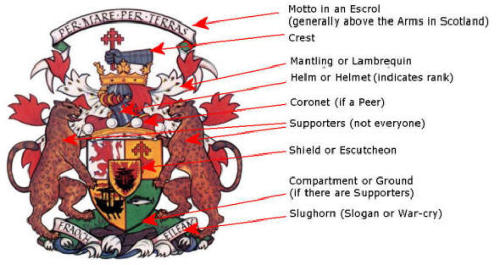
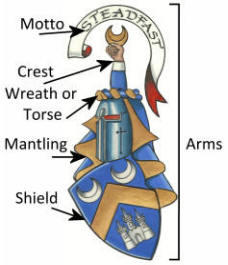
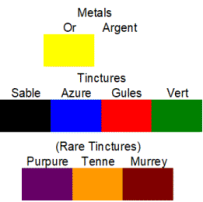
Or = gold
Argent = silver
(usually depicted as white)
Sable = black
Azure = blue
Gules = red
Vert = green
In order to avoid confusion colours
and metals are usually given capital
letters
(e.g., Sable, Or)
Basic rule - no metal on a metal, no
colours on a colour.
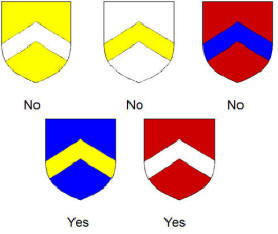





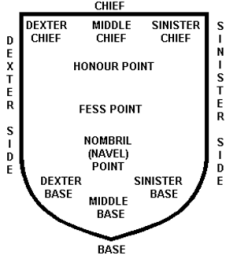

Blazon:
Argent, a stag's head cabossed proper, on a chief engrailed
Gules, a mullet between two crescents of the First.
(James Thomson, merchant, Kirkcaldy)
Read the blazon in this order...
1. The field of the escutcheon (shield) which here is Argent
2. The main charge or partition on the field (a stag's head)
3. Charges not central (in this case in chief)
4. Charges on the last mentioned (crescents and a mullet)
5. We try not to repeat ourselves, so of the First refers to the
first colour given, Argent
"Dexter" means right
and "sinister" means left
- but from the point of
view of the person
holding the shield, not
the viewer.
Argent is silver. "Cabossed" means a stag's head cut
off and shown as above. "Engrailed" is the scalloped
shape of the Chief. Gules is red. A "mullet" is a five-
pointed star.
THE ORDINARIES DIMINUTIVES
The simplest - and commonest - shapes on a shield are simple geometric designs. They have particular names.
Because they are the simplest, they also feature in the oldest Coats of Arms.
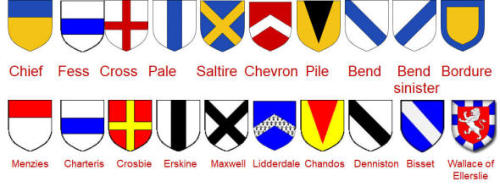
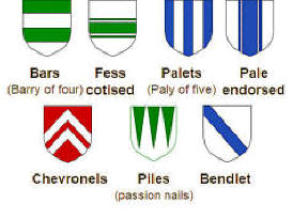
Divisions of the field - follow the same logic...
...as do positions on the field
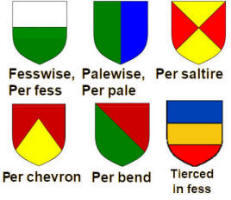
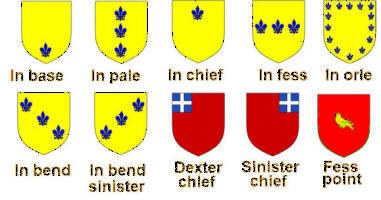
PATTERNS AND LINES
Patterns are often made from Diminutives
Lines of Division - may be applied to any line or charge
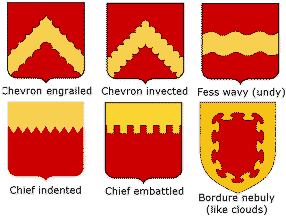
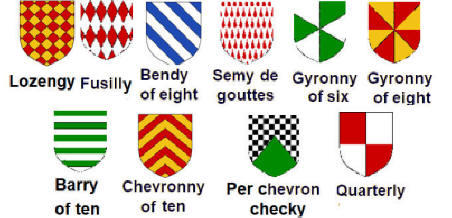
fusil = a flint; semy = patterned; gouttes = drops (blood or water)
Notice, by the way, the shield shape is not important, unless specified in the Blazon
COMMON CHARGES
A "charge" is anything on the shield - which could be a geometric shape, as above,
an animal, an inanimate object, etc. Here are some of the most commonly found.
There are many forms of cross, including...
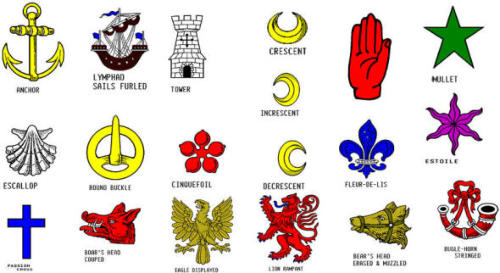
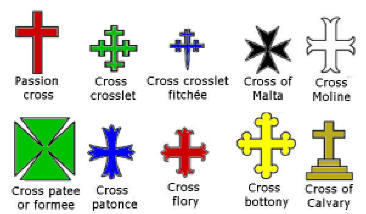
ATTITUDES OF BEASTS
If there is an animal in the Arms, it is necessary to say what it is doing - and different classes of "beasts" have their own vocabularies.
“armed" = claws, "langued" = tongue, "gardant" = facing forward, "regardant" = facing backward, "dormant" = sleeping, "passant" = walking, "Proper" = the colour in nature.
"attired" = stag's antlers, "displayed" = wings out, "urvant" = head elevated, "erased" = as if torn off, "couped" = as if cut off, "vulning" is particular to pelicans and
means drawing blood to feed her chicks, "naiant" = swimming, "volant" = flying, "gorged" = collar around the neck.
LET’S BLAZON
There are no "family Coats of Arms" - all Arms are individual to a person. However, everyone of the same surname will usually have Arms based on similar "undifferenced" Arms (usually those of the Chief).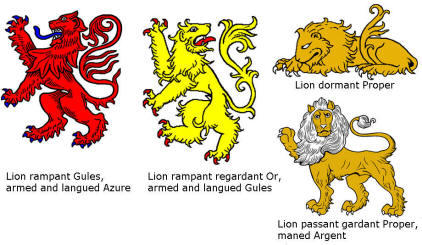
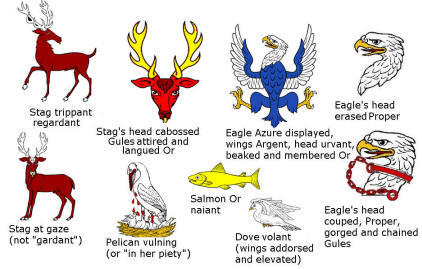
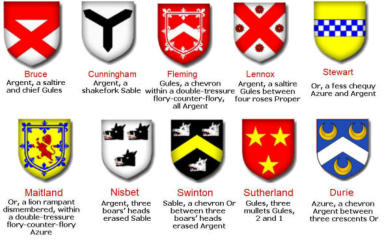
Follow the blazoning logic here...
Quarterly: 1st and 4th Or, a fess chequy Azure
and Argent (for Stewart); 2nd and 3rd Azure,
three garbs Or (for the Earldom of Buchan)
Arms of Stewart, Earl of Buchan
"garbs" = sheaves of wheat or corn
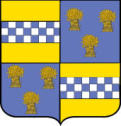
Marshalling - putting Arms together





Here is a good example of this in practice -
the Arms (here in the form of a banner) of Richard Walter
John Montagu Douglas Scott, 10th Duke of Buccleuch and
12th Duke of Queensberry KBE, DL

They show the senior patrilineal descendant of Sir
James Scott, 1st Duke of Monmouth, eldest
illegitimate son of Charles II and Lucy Walter, who
married Anne Scott, 4th Countess of Buccleuch. he
took her surname, and the Scott Arms (shown here)
appear an an escutcheon of pretence.
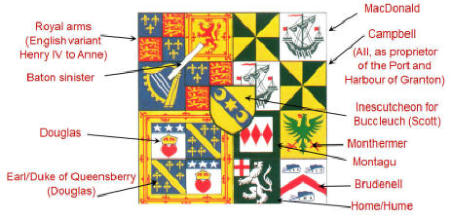
HELM, CREST, TORSE & MANTLING
The Helm indicates rank
The rank of a Peer is shown by the Coronet
Wreath or Torse




Sovereign - burnished gold,
affronty, i.e. face-on, with
six bars, or grilles, and lined
with crimson.
Noble (Peer) - silver or
polished steel, with gold
bars or grilles, and lined
with crimson
Baronets and Knights -
affronty (facing forward)
with an open visor.
Esquires and private
gentlemen - a barrel helmet
of steel, in profile, with the
visor or beaver closed.
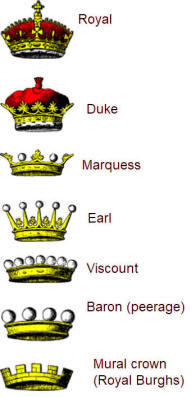
Normally the Crest rests on a
Wreath or Torse "of the liveries"
(main colours of the shield)
Here, the Torse is Azure and Or
Likewise the Mantling, which
hangs from the Torse, is Azure
doubled Or ("doubled" meaning
the inside colour)

THE CRESTS
The Crest sits atop the Helm, and started as a way of identifying knights and nobles in battle or at a jousting tournament. Typically, it repeats
an element of the Arms, or refers to a family story, or is a pun.
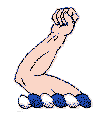







Armstrong Beveridge Durie Macpherson Cockburn Ruthven Wallace Wood
FINAL EXAMPLE - William Forbes-Sempill of Craigievar, Baronet, Baron Sempill (granted 1885)

These Arms were granted when Sir William Forbes assumed the title and surname of Sempill.
The shield is blazoned:
Quarterly: 1st and 4th Argent, a chevron chequy Gules and of the First between three
huntinghorns Sable, garnished and stringed of the Second (for Sempill); 2nd and 3rd Azure, a
cross patée fitchée Or between three bears' heads couped Argent, muzzled Gules (for Forbes).
The Helm is that of a Noble, atop the Coronet of a Lord of Parliament.
Unusually, there are two Crests and Mottos, Keep Tryst taken from Sempill (on the dexter) and
Watch from Forbes (sinister).
The orange tawny Ribbon and Badge of a Baronet of Nova Scotia surround the shield.
As a Peer (and also as a Chief), the Armiger has Supporters - two greyhounds Argent collared
Gules
It may be (no-one is really sure) that assume that hunting was one of the attractions of the
lands around Lochwinnoch, hence the hurting horns, stag's head atd dogs.
The current Lord Sempill says: "I have always thought that James IV had a sense of guilt in
regards to those who died supporting his father at Sauchiburn, which is why John Sempill was
made a Lord of Parliament".
Sempill/Semple
Forbes


Mr. Barr (Gules, a fess Or)
meets Ms. Cross (Argent, a cross
Azure)
They marry, become the
Cross-Barrs, and their Arms
are impaled
(put side by side..
...unless Ms. Barr is an Armigerous
Heiress (inherits her father's Arms),
in which case Mr. Barr adds hers as
an escutcheon of pretense to show
he is carrying the arms for the
benefit of the grandchildren of his
wife’s father...
...and their children bear quartered
Arms: Quarterly: 1st and 4th Gules, a
fess Or; 2nd and 3rd Argent, a cross
Azure. Note that the male name
(Barr) comes last, and the paternal
Arms go in the 1st and 4th quarters.
This can be read like a visual Family
Tree.
©Bruce Durie & Court of the Lord Lyon MMXXI













